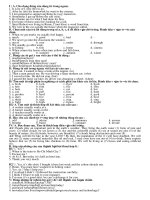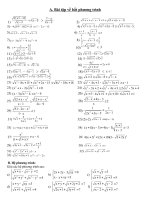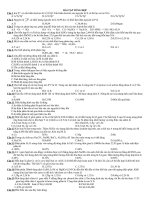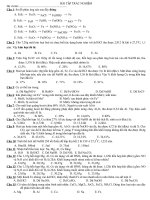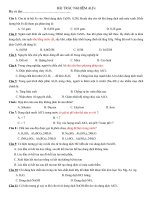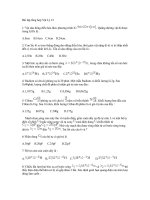- Trang chủ >>
- Đại cương >>
- Kinh tế lượng
Bài tập tổng hợp - C7
Bạn đang xem bản rút gọn của tài liệu. Xem và tải ngay bản đầy đủ của tài liệu tại đây (241.18 KB, 5 trang )
<span class='text_page_counter'>(1)</span><div class='page_container' data-page=1>
0095-1137/95/$04.0010
Copyrightq1995, American Society for Microbiology
Detection of Porcine Reproductive and Respiratory
Syndrome Virus in Boar Semen by PCR†
JANE CHRISTOPHER-HENNINGS,
1<sub>* ERIC A. NELSON,</sub>
1<sub>JULIE K. NELSON,</sub>
1<sub>REBECCA J. HINES,</sub>
1SABRINA L. SWENSON,
2<sub>HOWARD T. HILL,</sub>
2<sub>JEFF J. ZIMMERMAN,</sub>
2<sub>JON B. KATZ,</sub>
3MICHAEL J. YAEGER,
1<sub>CHRISTOPHER C. L. CHASE,</sub>
1AND
DAVID A. BENFIELD
1<i>Department of Veterinary Science, South Dakota State University, Brookings, South Dakota 57007</i>
1<i><sub>; Veterinary</sub></i>
<i>Diagnostic Laboratory, College of Veterinary Medicine, Iowa State University, Ames, Iowa 50011</i>
2<i><sub>; and</sub></i>
<i>National Veterinary Services Laboratory, Veterinary Services, Animal and Plant Health</i>
<i>Inspection Service, U.S. Department of Agriculture, Ames, Iowa 50010</i>
3Received 2 December 1994/Returned for modification 9 March 1995/Accepted 30 March 1995
<b>Porcine reproductive and respiratory syndrome virus (PRRSV) causes a devastating disease in swine. The</b>
<b>presence and transmission of PRRSV by boar semen has been demonstrated by using a swine bioassay. In this</b>
<b>assay, 4- to 8-week-old pigs were inoculated intraperitoneally with semen from PRRSV-infected boars. </b>
<b>Sero-conversion of these piglets indicated the presence of PRRSV in semen. SeroSero-conversion in gilts has also been</b>
<b>demonstrated following artificial insemination with semen from PRRSV-infected boars. These methods of</b>
<b>detecting PRRSV in boar semen are time-consuming, laborious, and expensive. The objective of this study was</b>
<b>to develop a reliable and sensitive PCR assay to directly detect PRRSV in boar semen. Primers from open</b>
<b>reading frames 1b and 7 of the PRRSV genome were used in nested PCRs. Virus was detected at concentrations</b>
<b>as low as 10 infectious virions per ml in PRRSV-spiked semen. Specificity was confirmed by using a nested PCR</b>
<b>and a</b>
<b>32</b><b>P-labeled oligonucleotide probe. The primers did not react with related arteriviruses or other swine</b>
<b>viruses. The PCR assay showed good correlation with the swine bioassay, and both methods were superior to</b>
<b>virus isolation. To consistently identify PRRSV in boar semen, the cell fraction was separated by centrifugation</b>
<b>at 600</b>
3
<i><b>g</b></i>
<b>for 20 min, a lysis buffer without a reducing agent (2-mercaptoethanol) was used, and nondiluted</b>
<b>and 1:20-diluted cell fractions were evaluated by PCR. PRRSV was not reliably detected in the seminal plasma</b>
<b>fraction of boar semen.</b>
Porcine reproductive and respiratory syndrome (PRRS) is
now recognized as an important disease of swine throughout
the world (1, 9). The disease affects pigs of all ages and causes
poor conception rates, late-term abortions, and stillborn and
weak pigs. Respiratory distress accompanied by fever,
hyper-pnea, lethargy, and high mortality rates is seen in suckling,
weaned, and grow-finish pigs (14, 22). In 1991, a small RNA
virus called the Lelystad virus (LV) was isolated in The
Neth-erlands and was identified as the cause of PRRS (22).
Subse-quently, a similar virus (VR-2332) was identified and
charac-terized in the United States (2, 5). Both the LV and the
VR-2332 PRRS virus (PRRSV) isolates have morphologic,
physicochemical, and genetic properties similar to those of the
arteriviruses, which include equine arteritis virus, lactate
de-hydrogenase elevating virus, and simian hemorrhagic fever
vi-rus (2, 6, 12, 22).
While the etiologic agent of PRRS has been identified and
characterized, many aspects of the disease have only recently
been described. Investigations in the United Kingdom (15) and
the United States (19, 24) indicated that infected boars
trans-mitted PRRSV in semen. These reports have further
height-ened concerns in the world swine industry, which is becoming
more reliant on artificial insemination and the use of boar
semen to introduce new genetic information into
high-health-status herds. There are also concerns that trade restrictions
may be placed on semen from countries with PRRSV-positive
pigs (19). Identification of viruses in semen by conventional
methods such as virus isolation (VI) is difficult to perform
because of the cytotoxicity of semen samples (18). A swine
bioassay (19) has also been developed whereby 13 to 15 ml of
semen is injected intraperitoneally into a 4- to 8-week-old pig.
This pig is then monitored for seroconversion to the PRRSV.
Both of these methods are time-consuming, laborious, and
expensive. However, PCR has the potential to provide a
sen-sitive, rapid, and specific method to detect PRRSV in boar
semen. PCR has been previously utilized in identifying human
immunodeficiency virus (11), bovine herpesvirus 1 (20, 23),
and equine arteritis virus (3) in human, bovine, and equine
semen, respectively.
In this study, we describe the development of PCR for
de-tecting PRRSV RNA in boar semen. A comparison was made
among PCR, the swine bioassay, and VI for their ability to
identify PRRSV in boar semen. Good correlation between
PCR and the swine bioassay was observed, but poor sensitivity
was obtained when VI was used. Consistency in detecting
PRRSV-infected semen was obtained when the cell fraction of
the semen was used for PCR analysis. A lysis buffer without a
reducing agent (2-mercaptoethanol) was utilized for RNA
ex-traction, and an undiluted cell fraction and a 1:20 dilution of
the cell fraction were also needed to obtain optimal results by
PCR. A PCR for detection of PRRSV in boar semen will be
useful as a diagnostic tool, since PRRV transmission through
boar semen has been demonstrated (24). PCR will also be
useful in defining the pathogenesis of PRRSV in reproductive
disease.
<b>MATERIALS AND METHODS</b>
<b>Animals, experimental inoculation, and protocol.</b>Five PRRSV-seronegative
boars were obtained and housed at Iowa State University as previously described
* Corresponding author. Mailing address: Box 2175, Department of
Veterinary Science, South Dakota State University, Brookings, SD
57007. Phone: (605) 688-5171. Fax: (605) 688-6003.
† South Dakota Experiment Station paper 2836.
</div>
<span class='text_page_counter'>(2)</span><div class='page_container' data-page=2>
(19). Four of these boars (boars 115, 117, 119, and 125) were inoculated with 2
ml of the ATCC VR-2402 PRRSV isolates per naris at a concentration of 106.5
50% tissue culture infective dose per ml. Semen was collected twice weekly for
8 weeks following experimental inoculation (19). Boar 121 was used as an
uninoculated control and semen was collected once weekly from this boar as
previously described (19). Sperm-rich and sperm-poor fractions were collected
separately and stored at2808C in 4- to 5-ml aliquots (19).
<b>Viruses and cells.</b>The ATCC VR-2402 PRRSV isolate was originally isolated
on porcine alveolar macrophages and adapted to an African green monkey
kidney continuous cell line (MA-104) as previously described (19). For VI,
MARC-145 cells were utilized (10). These cells were derived by cloning from the
MA-104 parent cell line and yielded a higher virus titer than MA-104 cells (10).
<b>VI.</b>Two milliliters of whole semen was freeze-thawed, mixed with 20 ml of
Hanks balanced salt solution, and centrifuged at 40,0003<i>g for 1 h. The </i>
super-natant was discarded, and the pellet was resuspended and vortexed in 1 ml of
minimum essential medium with 2% horse serum. Confluent monolayers of
MARC-145 cells were inoculated with 200ml of the suspension at 1:2 and 1:40
dilutions in minimum essential medium with 2% horse serum. After incubation
for 2 h at 378C, the supernatant was discarded, 1.5 ml of replacement medium
(minimum essential medium with 2% horse serum) was added to each well, and
the inoculated cell cultures were then incubated at 378C for 40 to 48 h. The
supernatants were discarded, and 1 ml of 80% acetone was added to each well for
15 min and then discarded. Plates were air dried, and 200ml of
fluorescein-conjugated anti-PRRSV monoclonal antibody (SDOW 17) (13) was added to
each well and incubated 30 min at 378C. Wells were then washed three times with
phosphate-buffered saline (PBS) (pH 7.2) and evaluated by fluorescence
micros-copy. If detectable virus-specific fluorescence was present in any cells of the
monolayer, the sample was considered positive for PRRSV by VI.
<b>Swine bioassay.</b>The swine bioassay for the detection of PRRSV in semen has
been previously described (19). Briefly, one 4- to 8-week-old pig was inoculated
intraperitoneally with a 13- to 15-ml sample of semen (equal volumes of
sperm-rich and sperm-poor fractions) from a single collection. Pigs were then
moni-tored serologically at weekly intervals by using the indirect fluorescent-antibody
test. Two or more consecutive indirect fluorescent-antibody-positive results from
weekly blood samples of the same pig were considered indicative of infective
PRRSV in the semen.
<b>Separation of seminal fractions.</b>For all but two samples, 1 ml of sperm-rich
and 1 ml of sperm-poor fractions (19) were used for PCR. For boars 115 and 117
at 3 days postinoculation (DPI), 3 ml of sperm-rich and 3 ml of sperm-poor
fractions were used. Semen was then separated into cellular and seminal plasma
fractions by centrifugation at 6003<i>g for 20 min (8). Seminal plasma was</i>
removed to approximately 1 in (2.54 cm) above the cell fraction layer, and the
remaining seminal plasma was discarded. The cell fraction was washed once with
PBS and stored at2708C. Seminal plasma was also stored at2708C.
<b>Sample preparation and extraction of PRRSV RNA.</b>Semen samples were
processed similarly to the method described by Chomczynski and Sacchi (4), with
minor modifications. When either whole semen or seminal plasma fractions were
tested, 500ml was added to an equal volume of lysis buffer (4 M guanidinium
<i>thiocyanate, 25 mM sodium citrate [pH 7], 0.5% Sarkosyl [N-lauryl sarcosine],</i>
0.1 M 2-mercaptoethanol). When the cell fraction of the semen was used, 500ml
of lysis buffer without 2-mercaptoethanol was mixed with an equal volume of
cells. Fifty microliters of this mixture was then added to an additional 450ml of
lysis buffer without 2-mercaptoethanol for a 1:20 dilution. Siliconized
polypro-pylene tubes were used for all extraction procedures (USA/Scientific Plastics,
Ocala, Fla.). Five hundred microliters of the lysates was then added to 250ml of
phenol and 250ml of chloroform-isoamyl alcohol (24:1), and the mixtures were
vortexed and centrifuged at 10,0003<i>g for 5 min. The upper aqueous phase was</i>
retained and extracted again with phenol-chloroform-isoamyl alcohol and once
with 500ml of chloroform-isoamyl alcohol. The volume of the upper phase was
estimated, and 1/3 volume of 2 M sodium acetate (pH 4) and 2 volumes of cold
95% ethanol were added. The sample was chilled at2708C for 1 h and then
centrifuged for 30 min at 16,0003<i>g. Ethanol was carefully removed, and the</i>
pellet was washed twice with 100ml of 70% ethanol. The pellet was then air dried
and reconstituted in 30ml of distilled water (Gibco, Grand Island, N.Y.).
<b>PCR primers and probe.</b>The primers and probe from open reading frame
(ORF) 7 were designed in our laboratory and derived from the PRRSV VR-2332
sequence (a U.S. PRRSV isolate). Sequence information was kindly provided by
Michael Murtaugh, University of Minnesota, St. Paul. The outer and nested
primers were made by Integrated DNA Technologies, Inc., Coralville, Iowa. The
outer sense and antisense primers were 59-TCGTGTTGGGTGGCAGAAAA
GC-39(nucleotides 2763 to 2785) and 59-GCCATTCACCACACATTCTTCC-39
(nucleotides 3247 to 3225), respectively. The nested sense and antisense primers
were 59-CCAGATGCTGGGTAAGATCATC-39(nucleotides 2885 to 2907) and
59-CAGTGTAACTTATCCTCCCTGA-39(nucleotides 3121 to 3099),
respec-tively. The internal probe was 59-TGTCAGACATCACTTTACCC-39
(nucleoti-des 3002 to 3022). Outer and nested primers derived from ORF 1b of the LV
sequence (a European PRRSV isolate) were also used. The outer sense and
antisense primers were 59-CCGTCACCAGTGTGTCCAA-39(nucleotides 8751
to 8771) and 59-CCGTTCTGAAACCCAGCAT-39(nucleotides 9003 to 8984),
respectively. The seminested sense and antisense primers were 59-ACATGG
TATTGTCGGCCTT-39(nucleotides 8803 to 8822) and 59-CGTTCTGAAAC
CCAGCATC-39(nucleotides 9002 to 8983), respectively. For our study, only
ORF 7 primers were utilized to evaluate semen samples by PCR, since the boars
had been inoculated with the VR-2402 isolate (a U.S. PRRSV isolate).
<b>Reverse transcription.</b>The PRRSV RNA was reverse transcribed with
re-agents from a GeneAmp RNA PCR kit (Applied Biosystems, Foster City, Calif.),
and the reaction was carried out in oil-free tubes (Barnstead/Thermolyne,
Du-buque, Iowa). Two microliters of extracted RNA was added to a mixture
con-taining final concentrations of 5 mM MgCl2solution, 13PCR buffer II (103
PCR buffer consisted of 500 mM KCl and 100 mM Tris-HCl), 1 mM each
deoxynucleotide triphosphate (dNTP), 1 U of RNase inhibitor perml, 2.5 U of
reverse transcriptase perml, and 0.75mM antisense outer primer plus 1ml of
sterile distilled water for a 20-ml total volume per sample. All reagents and
mixtures were kept on ice and then placed in a thermal cycler (Temp-tronic;
Barnstead/Thermolyne) for 1 cycle at 428C for 15 min, 998C for 5 min, and 58C
for 5 min.
<b>Outer and nested PCRs and visualization of PCR products.</b>For outer DNA
segment amplification, an 80-ml PCR mixture with final concentrations of 2 mM
MgCl2, 13PCR buffer II, 0.15m<i>M outer sense primer, and 2.5 U of Taq DNA</i>
polymerase per 100ml plus 65.5ml of sterile distilled water was added to the
same tube as the reverse transcription product. This mixture (100-ml total
vol-ume) was then placed in the thermal cycler for 40 cycles at 958C for 25 s, 588C
for 5 s, and 748C for 25 s. For nested DNA amplification, 2ml of the outer DNA
product was added to a fresh tube containing final concentrations of 3 mM
MgCl2<i>, 0.4 mM each dNTP, 2.5 U of DNA Taq polymerase per 50</i>ml, and 2.4mM
each of the nested sense and nested antisense primers plus 8ml of 103PCR
buffer II and 19.5ml of sterile distilled water in a 50-ml total volume. The nested
amplification was then performed in a thermal cycler for 30 cycles with the same
annealing, denaturing, and DNA extension temperatures and times as those used
for the outer reaction. After completion of the nested DNA amplification, 9ml
of each reaction mixture was mixed with 2ml of a 13sample buffer, type IV (17),
and separated on a 1% SeaKem (FMC Bioproducts, Rockland, Maine) agarose
gel containing 1mg of ethidium bromide per 2 ml of agarose. A 100-bp DNA
ladder (Gibco BRL, Grand Island, N.Y.) was used as a reference marker. The
484-bp outer ORF 7, 252-bp outer ORF 1b, 236-bp nested ORF 7, and 200-bp
seminested ORF 1b products were then visualized and photographed under UV
illumination.
<b>Quality control for PCR.</b>False-positive reactions may easily occur with PCR
which involves the use of nested primers, since these primers amplify an already
greatly amplified product. Precautions were taken to prevent these reactions.
Four separate rooms were used for RNA extraction, outer and nested PCR, and
agarose gel detection. In addition, lab coats and gloves were changed often, and
aerosol-resistant pipette tips and dedicated pipetters were utilized for each step
of the procedure. Positive and negative controls were also used with each group
of eight PCR samples.
<b>cDNA probe labeling and Southern hybridization.</b>The internal
oligonucleo-tide probe was labeled with [g-32<sub>P]ATP by using T4 polynucleotide kinase (U.S.</sub>
Biochemicals, Cleveland, Ohio). One microliter of 103T4 polynucleotide kinase
buffer (0.5 M Tris-HCl [pH 7.6], 100 mM MgCl2, 100 mM 2-mercaptoethanol)
was added to 1ml of 20mM oligonucleotide probe. Seven microliters of
10-mCi/ml (3,000 Ci/mmol) [g-32<sub>P]ATP and 1</sub><sub>m</sub><sub>l of T4 polynucleotide kinase (10</sub>
U/ml) were then added to the reaction tube. The solution was centrifuged briefly,
mixed, and incubated for 10 min at 378C. The reaction was then terminated by
heating at 658C for 5 min. For Southern blotting, the agarose gel was transferred
to a nylon membrane with a rapid transfer system (Turboblotter; Schleicher &
Schuell, Keene, N.H.). The DNA was fixed on the membrane with a UV
cross-linker at 120,000 J/cm2
. The membrane was then placed on 63SSC buffer for 2
min (203SSC stock solution consisted of 175.3 g of NaCl and 88.2 g of sodium
citrate in 800 ml of water [pH 7], adjusted to 1 liter and autoclaved).
Prehybrid-ization was performed for 1 h at 428C in 63SSC buffer–0.5% sodium dodecyl
sulfate (SDS)–100mg of denatured salmon sperm DNA per ml–53Denhardt’s
solution (503Denhardt’s solution consisted of 5 g of Ficoll, 5 g of
polyvinylpyr-rolidone, and 5 g of bovine serum albumin dissolved in water for a 500-ml total
volume and filtered through a disposable filter) (16). The prehybridization
so-lution was then discarded and the membrane was hybridized overnight at 428C in
63SSC buffer–10 mM EDTA–2 ml of labeled probe–0.5% SDS–100mg of
denatured salmon sperm DNA per ml–53Denhardt’s solution as previously
described (16). The membrane was then washed twice for 5 min each time in 50
ml of a mixture of 23SSC buffer and 0.5% SDS. The membrane was then air
dried and exposed to an X-ray film (X-OMAT; Kodak) for 5 h.
<b>RESULTS</b>
<b>Optimization of PCR amplification conditions.</b>
To improve
the specificity and sensitivity of the PCR, various MgCl2
con-centrations (1.6 to 5 mM), primer concon-centrations (0.2 to 0.4
</div>
<span class='text_page_counter'>(3)</span><div class='page_container' data-page=3>
<b>Specificity and sensitivity of the PCR amplification.</b>
Other
arteriviruses (equine arteritis virus and lactate dehydrogenase
elevating virus) did not react with primers derived from either
ORF 1b or ORF 7 of the PRRSV genome. Primers from ORF
7 did not react with six other swine viruses (transmissible
gas-troenteritis virus, porcine respiratory coronavirus, rotavirus,
pseudorabies virus, parvovirus, and swine influenza virus). To
date, seven U.S. PRRSV field isolates obtained through the
South Dakota State University Animal Disease Research and
Diagnostic Laboratory have been tested with both ORF 1b and
ORF 7 primers. All isolates reacted with both primer pairs.
These primers have also been tested with the European
PRRSV isolate LV. LV can be detected with primers designed
from the polymerase gene (ORF 1b of LV) but not with
prim-ers derived from the nucleocapsid gene (ORF 7 of the U.S.
VR-2332 isolate) (Fig. 1). The VR-232 PRRSV isolate can be
detected with both primer pairs (Fig. 1). An internal
radioac-tive probe was made from the ORF 7 VR-2332 sequence (Fig.
2).
The sensitivity of the PCR was also determined with a
10-fold dilution series of the VR-2332 isolate. As few as 10 virions
(1 log unit of virus) per ml could be detected with the ORF 7
nested primers (Fig. 3).
<b>Detection of PRRSV in boar semen by VI, the swine </b>
<b>bioas-say, and PCR.</b>
PRRSV from boar semen was infrequently
identified by VI compared with the swine bioassay or PCR
(Table 1). We did not observe significant cytotoxicity at a 1:40
dilution of semen, whereas cytotoxicity was occasionally
ob-served at a 1:2 dilution of semen.
PCR and swine bioassay results correlated except in 4 of 67
semen samples tested (Table 1). When performing PCR on
boar semen, we often observed that some semen samples
which were positive for PRRSV by the swine bioassay were
negative by both VI and PCR. We theorized that there may be
inhibitors in the seminal plasma or cell fraction of the semen
that interfered with the PCR. To test this theory, we separated
the cell fraction from the seminal plasma by centrifugation.
Seminal plasma and cell fractions were then separately assayed
by PCR. We observed good correlation between the PCR and
swine bioassay results when the cell fraction was assayed by
PCR. We did not detect PRRSV in the seminal plasma by PCR
unless we concentrated the seminal plasma by high-speed
cen-trifugation (40,000
3
<i>g for 1 h). However, only four of seven</i>
concentrated seminal plasma samples tested were positive
(data not shown). Subsequent to this study, we inoculated an
additional four boars with PRRSV and performed PCR on
samples of their semen. Eight samples were tested, and all
eight were negative when PCR was carried out on
nonconcen-trated seminal plasma fractions but positive when whole semen
was used for PCR (data not shown). These results indicated
that PRRSV is most consistently associated with the cell
frac-tion of the semen but not with the seminal plasma.
<b>DISCUSSION</b>
The objective of this study was to develop a reliable,
sensi-tive, and rapid test to directly identify PRRSV in boar semen.
In our study, the PCR assay fulfilled these requirements. To
consistently identify PRRSV-infected semen, we used
low-speed centrifugation to separate seminal plasma from the cell
fraction, extracted viral RNA from the cell fraction with a lysis
buffer without a reducing agent on undiluted and 1:20-diluted
cell fractions, and then carried out a nested PCR. The
reliabil-ity of the PCR assay was supported by good correlation
be-tween the results of the swine bioassay and those of the PCR.
Results from 63 of 67 semen samples tested showed
correla-tion between PCR and the swine bioassay (Table 1). For the
remaining four samples, the PCR assay was positive, while the
swine bioassay was negative. This could have occurred for
FIG. 1. Ethidium bromide-stained 1% agarose gel showing detection of the
Lelystad and ATCC VR-2332 PRRSV isolates. Primers from ORF 1b (the
polymerase gene) and ORF 7 (the nucleocapsid gene) are used for outer (O) and
nested (N) reactions. A 100-bp DNA ladder (L) was used as a reference marker.
FIG. 2. Hybridization of the32
P-labeled oligonucleotide probe to the outer
(O) (484-bp) and nested (N) (236-bp) ORF 7 PCR products shown in Fig. 1.
</div>
<span class='text_page_counter'>(4)</span><div class='page_container' data-page=4>
several reasons. In the majority of samples from boars 115 and
117, the PRRSV RNA was detected only in the cell fraction
and not in whole semen. This indicated that concentration of
the semen was necessary for detection, and only a small
amount of virus may have been present in the semen.
There-fore, limited detection by the swine bioassay might occur. For
boar 125, semen samples collected before and after 13 DPI
were positive by both PCR and the swine bioassay, and this
positivity occurred when viremia was present (19). Some
au-thors have suggested that semen samples may be contaminated
by serum or blood cells (21), and if viremia were present at 13
DPI, PRRSV might be found in the semen from serum or
blood cell contamination. Therefore, the discrepancy was likely
the result of a false-negative reaction involving the swine
bio-assay. Alternatively, since PCR detects physical particles (20)
and not necessarily infectious virus, a positive PCR and
nega-tive swine bioassay result could indicate that infectious
PRRSV was not present in that semen sample.
Increased sensitivity of PCR was observed when nested
primers rather than outer primers were used as well as when
the cell fraction of the semen was used. Initially, we
centri-fuged 1 ml of sperm-rich and 1 ml of sperm-poor semen
frac-tions to obtain the cell fraction. This amount of semen was
sufficient for correlating the results of the PCR with those of
the swine bioassay for all samples except those from boars 115
and 117 (3 DPI). In these cases, we needed to use 3 ml of
sperm-rich and 3 ml of sperm-poor fractions. Therefore, it
appears advantageous to use a minimum of 6 ml of semen to
obtain the cell fraction. Few virus particles may have been
present on the first day of PRRSV shedding (3 DPI) for these
two boars and a higher cell concentration may have been
required for PRRSV to be detected.
Using the cell fraction, other authors have found an
inhibi-tion of the PCR due to sperm cell DNA (20, 23). To prevent
this, we used a lysis buffer without 2-mercaptoethanol, a
re-ducing agent similar to dithiothreitol. Dithiothreitol was used
by Van Engelenburg et al. (20) and Mermin et al. (11) to
obtain virus from sperm cells. Reducing agents appear to cause
chromatin decondensation of sperm DNA (7) and this may
cause false-negative PCR results. Another modification of
PCR used to test semen was to dilute the cell fraction 1:20 in
lysis buffer. Of the 30 cell fraction samples we tested, 5 (17%)
were negative in the undiluted sample but positive in the
di-luted sample (data not shown). Therefore, the dilution allows
detection of the virus in at least some of the samples in which
virus might not be detected without dilution. The success of
this procedure may result from the dilution of inhibitors
present in the cell fraction.
PRRSV RNA extraction from the semen of
PRRSV-posi-tive boars has been previously described (21). These authors
used low-speed centrifugation to pellet cells and then extracted
RNA from the supernatant, and they concluded that there was
no evidence for the possibility of transmission of PRRSV by
semen. However, in our study, we consistently found PRRSV
in the cell fraction and not in seminal plasma. Subsequent to
our study, we inoculated an additional four boars with PRRSV
and performed PCR on semen samples from these boars. To
date, 15 seminal plasma samples have been tested by PCR and
were negative for PRRSV, even though they were positive by
the swine bioassay or by PCR on whole semen. Since 150 to
500 ml of boar semen may be obtained from a single collection,
the PRRSV may not be present in large quantities or be evenly
distributed in the semen. Therefore, a method of concentrating
the sample and reducing interference from inhibitors in semen
appears to be important for obtaining reliable PCR results.
Other extraction techniques and separations were attempted
in order to obtain consistent results for PCR with boar semen.
The extraction techniques described by Van Engelenburg et al.
(20) and Chirnside and Spaan (3) and an RNaid (Bio 101, La
Jolla, Calif.) procedure were used on the boar semen samples.
We also concentrated whole semen samples and used seminal
plasma samples (concentrated and nonconcentrated) to obtain
TABLE 1. Detection of PRRSV in boar semen by various assays
Boar Test<i>a</i> Result on DPI
<i>b</i>
0 3 5 7 9 11 13 15 17 19 21 23 25 27 29 31 33 35 37 39 41 43 45 47 49 51 53 56
115 Bio <sub>2 1</sub> <sub>1</sub> <sub>1</sub> <sub>1</sub> <sub>1</sub> <sub>1</sub> <sub>1</sub> <sub>1</sub> <sub>1</sub> <sub>2</sub> <sub>1</sub> <sub>2</sub> <sub>2</sub> <sub>2</sub>
PCR 2 1p 1p 1 1 1p 1p 1p 1p 1p 1p 1 1p 2 2
VI 2 2 2 1 2 2 2 2 2 2 2 2 2 2 2
117 Bio 2 1 1 1 1 1 1 1 2 2 2 2 2 2 2
PCR 2 1p 1p 1 1 1 1p 1p 2 1p 2 2 2 2 2
VI 2 2 2 1 2 2 2 2 2 2 2 2 2 2 2
119 Bio 2 1 1 1 2 2 2 2 2 2 2 2 2 2
PCR 2 1 1 1 2 2 2 2 2 2 2 2 2 2
VI 2 2 2 2 2 2 2 2 2 2 2 2 2 2
125 Bio 2 1 1 2 1 1 1 2 2 2 2 2 2 2
PCR <sub>2</sub> <sub>1</sub> <sub>1</sub> <sub>1</sub> <sub>1</sub> <sub>1</sub> <sub>1</sub> <sub>2</sub> <sub>2</sub> <sub>2</sub> <sub>2</sub> <sub>2</sub> <sub>2</sub> <sub>2</sub>
VI 2 1 2 2 2 2 2 2 2 2 2 2 2 2
121 Bio 2 2 2 2 2 2 2 2 2
PCR <sub>2</sub> <sub>2</sub> <sub>2</sub> <sub>2</sub> <sub>2</sub> <sub>2</sub> <sub>2</sub> <sub>2</sub> <sub>2</sub>
VI 2 2 2 2 2 2 2 2 2
<i>a</i><sub>Bio, swine bioassay.</sub>
<i>b</i><sub>For the swine bioassay,</sub><sub>1</sub><sub>indicates seroconversion of a 4- to 8-week-old piglet inoculated intraperitoneally with PRRSV-infected boar semen. For PCR,</sub><sub>1</sub><sub>p</sub>
indicates detection of a 236-bp nested PCR product resulting from the presence of PRRSV genomic RNA in the cell fraction of semen but not in whole semen and
</div>
<span class='text_page_counter'>(5)</span><div class='page_container' data-page=5>
viral RNA from boar semen. However, these techniques were
not consistent in identifying PRRSV-infected semen. When we
obtained the cell fraction of boar semen by low-speed
centrif-ugation and then used a lysis buffer without a reducing agent
(2-mercaptoethanol) on the cell fraction for viral RNA
extrac-tion, PCR results consistently correlated with those of the
swine bioassay. Both an undiluted cell fraction and a 1:20
dilution of the cell fraction in lysis buffer were used for PCR
analysis.
Since we have primers which react with both U.S. and
Eu-ropean isolates of the PRRSV, this assay will be useful as a
diagnostic tool and will detect PRRSV in clinically ill and
convalescent boars. The PCR assay will be particularly useful
for semen supply companies that are under pressure to sell
virus-free semen which could be used worldwide. It will also be
valuable in determining the pathogenesis of PRRSV in
repro-ductive disease. Further studies are needed to determine the
effect of using PRRSV-infected semen to inseminate sows
and/or gilts. Preliminary data has shown that seroconversion
and decreased conception rates in gilts can occur from using
this semen (24). Also, dissemination of the virus to other
se-ronegative pigs could possibly occur from these sows and/or
gilts. Since a vaccine for PRRSV infection in adult swine is not
currently available, screening of semen samples for PRRSV is
an important aspect of controlling this disease. In this study, we
determined that PRRSV is predominantly found in the cell
fraction of semen. Future studies are now in progress to
de-termine if the virus is adsorbed to the spermatozoa or is
actu-ally carried in nonsperm cells or sperm.
<b>ACKNOWLEDGMENTS</b>
This work was supported by USDA-NRI Seed Grant 9404056,
USDA-NPICGP Grant 9203683, a South Dakota Agricultural
Exper-iment Station Hatch grant, the National Pork Producers Council, the
South Dakota Pork Producers Council, and Miles, Inc.
We thank Alan K. Erickson and Larry D. Holler for reviewing the
manuscript.
<b>REFERENCES</b>
<b>1. Ahl, R., M. Pensaert, I. B. Robertson, C. Terpstra, W. van der Sande, K. J.</b>
<b>Walker, M. E. White, and M. Meredith.</b>1992. Porcine reproductive and
<b>respiratory syndrome (PRRS or blue-eared pig disease). Vet. Rec. 130:87–</b>
89.
<b>2. Benfield, D. A., E. Nelson, J. E. Collins, L. Harris, S. M. Goyal, D. Robison,</b>
<b>W. T. Christianson, R. B. Morrison, D. Gorcyca, and D. Chladek.</b>1992.
Characterization of swine infertility and respiratory syndrome (SIRS) virus
<b>(isolate ATCC VR-2332). J. Vet. Diagn. Invest. 4:127–133.</b>
<b>3. Chirnside, E. D., and W. J. M. Spaan. 1990. Reverse transcription and</b>
cDNA amplification by the polymerase chain reaction of equine arteritis
<b>virus (EAV). J. Virol. Methods 30:133–140.</b>
<b>4. Chomzynski, P., and N. Sacchi. 1987. Single-step method of RNA isolation</b>
by acid guanidinium thiocyanate-phenol-chloroform extraction. Anal.
<b>Bio-chem. 162:156–159.</b>
<b>5. Collins, J. E., D. A. Benfield, W. T. Christianson, L. Harris, J. C. Hennings,</b>
<b>D. P. Shaw, S. M. Goyal, S. McCullough, R. B. Morrison, H. S. Joo, D.</b>
<b>Gorcyca, and D. Chladek.</b>1992. Isolation of swine infertility and respiratory
syndrome virus (isolate ATCC VR-2332) in North America and
experimen-tal reproduction of the diseases in gnotobiotic pigs. J. Vet. Diagn. Invest.
<b>4:117–126.</b>
<b>6. Conzelmann, K. K., N. Visser, P. Van Woensel, and H. J. Thiel. 1993.</b>
Molecular characterization of porcine reproductive and respiratory
<b>syn-drome virus, a member of the Arterivirus group. Virology 193:329–339.</b>
<b>7. Evenson, D. P., Z. Darzynkiewicz, and M. R. Melamed. 1980. Comparison of</b>
human and mouse sperm chromatin structure by flow cytometry.
<b>Chromo-soma 78:225–238.</b>
<b>8. Gerfen, R. W., B. R. White, M. A. Cotta, and M. B. Wheeler. 1994. </b>
Com-parison of the semen characteristics of Fengjing, Meishan, and Yorkshire
<b>boars. Theriogenology 41:461–469.</b>
<b>9. Keffaber, K. K. 1989. Reproductive failure of unknown etiology. Am. Assoc.</b>
<b>Swine Practitioners Newsl. 2:1–10.</b>
<b>10. Kim, H. S., J. Kwang, I. J. Yoon, H. S. Joo, and M. L. Frey. 1993. Enhanced</b>
replication of porcine reproductive and respiratory syndrome (PRRS) virus
<b>in a homogeneous subpopulation of MA-104 cell line. Arch. Virol. 133:477–</b>
483.
<b>11. Mermin, J. H., M. Holodniy, D. A. Katzenstein, and T. C. Merigan. 1991.</b>
Detection of human immunodeficiency virus DNA and RNA in semen by the
<b>polymerase chain reaction. J. Infect. Dis. 164:769–772.</b>
<b>12. Meulenberg, J. J. M., M. M. Hulst, E. J. de Meuer, P. L. J. M. Moonen, A.</b>
<b>den Besten, E. P. de Kluyver, G. Wensvoort, and R. J. M. Moormann.</b>1993.
Lelystad virus, the causative agent of porcine epidemic abortion and
<b>respi-ratory syndrome (PEARS), is related to LDV and EAV. Virology 192:62–72.</b>
<b>13. Nelson, E. A., J. Christopher-Hennings, T. Drew, G. Wensvoort, J. E. </b>
<b>Col-lins, and D. A. Benfield.</b>1993. Differentiation of U.S. and European isolates
of porcine reproductive and respiratory syndrome virus by monoclonal
<b>an-tibodies. J. Clin. Microbiol. 31:3184–3189.</b>
<b>14. Ohlinger, V. F., F. Weiland, B. Haas, N. Visser, R. Ahl, T. C. Mettenleiter,</b>
<b>L. Weiland, H. J. Rziba, A. Saalmuller, and O. C. Straub.</b>1991. Der
‘‘seuchenhafte Spatabort beim Schwein’’—ein Beitrag zur Atiologie des
‘‘porcine reproductive and respiratory syndrome (PRRS).’’ Tieraerztl.
<b>Um-sch. 46:703–708.</b>
<b>15. Robertson, I. B. 1992. New pig disease update: epidemiology of PRRS. Pig</b>
<b>Vet. J. 29:186–187.</b>
<b>16. Sambrook, J., E. F. Fritsch, and T. Maniatis. 1989. Molecular cloning: a</b>
laboratory manual, 2nd ed., p. 387–389. Cold Spring Harbor Laboratory,
Cold Spring Harbor, N.Y.
<b>17. Sambrook, J., E. F. Fritsch, and T. Maniatis. 1989. Molecular cloning: a</b>
laboratory manual, 2nd ed., p. 455. Cold Spring Harbor Laboratory, Cold
Spring Harbor, N.Y.
<b>18. Schultz, R. D., I. S. Adams, G. Letchworth, B. E. Sheffy, T. Manning, and B.</b>
<b>Bean.</b>1982. A method to test large numbers of bovine semen samples for
viral contamination and results of a study using this method. Theriogenology
<b>17:115–123.</b>
<b>19. Swenson, S. L., H. T. Hill, J. J. Zimmerman, L. E. Evans, J. G. Landgraf,</b>
<b>R. W. Wills, T. P. Sanderson, M. J. McGinley, A. K. Brevik, D. K. Ciszewski,</b>
<b>and M. L. Frey.</b>1994. Excretion of porcine reproductive and respiratory
syndrome virus in semen after experimentally induced infection in boars. J.
<b>Am. Vet. Med. Assoc. 204:1943–1948.</b>
<b>20. Van Engelenburg, F. A. C., R. K. Maes, J. T. Van Oirschot, and F. A. M.</b>
<b>Rijsewijk.</b>1993. Development of a rapid and sensitive polymerase chain
reaction assay for detection of bovine herpesvirus type 1 in bovine semen. J.
<b>Clin. Microbiol. 31:3129–3135.</b>
<b>21. Van Woensel, P., J. Van Der Wouw, and N. Visser. 1994. Detection of</b>
porcine reproductive respiratory syndrome virus by the polymerase chain
<b>reaction. J. Virol. Methods 47:273–278.</b>
<b>22. Wensvoort, G., C. Terpstra, J. M. A. Pol, E. A. der Laak, M. Bloemrad, E. P.</b>
<b>deKluyer, C. Kragten, L. van Buiten, A. den Besten, F. Wagenaar, J. M.</b>
<b>Broekhuijsen, P. L. J. M. Moonen, T. Zetstra, E. A. de Boer, H. J. Tibben,</b>
<b>M. F. de Jong, P. van’t Veld, G. J. R. Groenland, J. A. van Gennep, M. T.</b>
<b>Voets, J. H. M. Verheijden, and J. Braamskamp.</b>1991. Mystery swine disease
<b>in the Netherlands: the isolation of Lelystad virus. Vet. Q. 13:121–130.</b>
<b>23. Wiedmann, M., R. Brandon, P. Wagner, E. J. Dubovi, and C. A. Batt. 1993.</b>
Detection of bovine herpesvirus-1 in bovine semen by a nested PCR assay.
<b>J. Virol. Methods 44:129–140.</b>
</div>
<!--links-->

